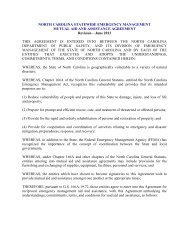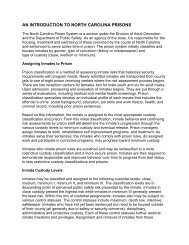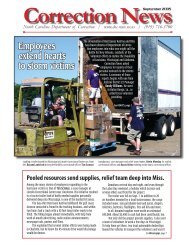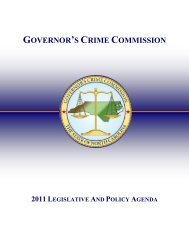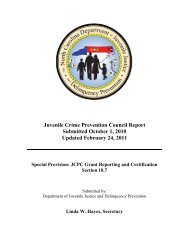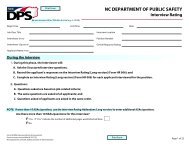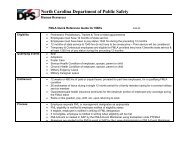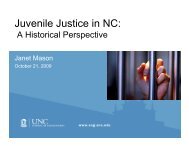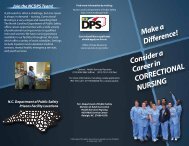Governor's Gang Task Force Final Report - North Carolina ...
Governor's Gang Task Force Final Report - North Carolina ...
Governor's Gang Task Force Final Report - North Carolina ...
Create successful ePaper yourself
Turn your PDF publications into a flip-book with our unique Google optimized e-Paper software.
Governor’s Crime CommissionDepartment of Public SafetyState of <strong>North</strong> <strong>Carolina</strong>1201 Front St.Raleigh, NC 27609Governor’s <strong>Gang</strong> <strong>Task</strong><strong>Force</strong> <strong>Final</strong> <strong>Report</strong>December 20, 20120
Table of ContentsDedication .................................................................................................................................................... 3Governor’s <strong>Gang</strong> <strong>Task</strong> <strong>Force</strong> Members ................................................................................................... 4GCC Staff assisting the <strong>Gang</strong> <strong>Task</strong> <strong>Force</strong> ............................................................................................ 5Introduction ................................................................................................................................................. 6Need for a Comprehensive Plan ................................................................................................................ 7The Comprehensive <strong>Gang</strong> Model .............................................................................................................. 8Recommendations and Implementation Steps ....................................................................................... 11General Recommendations and Implementation ................................................................................ 11Recommendation 1: Implement a comprehensive gang reduction model ................................ 11Recommendation 2: Create a web portal of effective programs and resources ......................... 12Recommendation 3: Evaluate and expand the NC Street <strong>Gang</strong> Suppression Act...................... 12Prevention Sub-Committee Recommendations and Implementation ................................................. 14Recommendation 1: Provide gang recognition and awareness training .................................... 14Recommendation 2: Implement community forums on gang recognition and awareness......... 14Recommendation 3: Work with the community to identify the gaps and opportunities inprogram services and activities ................................................................................................. 14Intervention Sub-Committee Recommendations and Implementation ............................................... 15Recommendation 1: Implement a comprehensive intervention program for at risk and/or ganginvolved individuals and their families ..................................................................................... 15Recommendation 2: Identify and implement cultural sensitivity training ................................. 15Recommendation 3: Implement and support alternatives to high school education ................. 16Suppression Sub-Committee Recommendations and Implementation ............................................... 17Recommendation 1: Adding a Special Assistant U.S. Attorney in each needed prosecutorialdistrict to handle gang-related crime ......................................................................................... 17Recommendation 2: Expand the N.C. SBI Field Liaison Officer Program to include gangtraining and retention of gang-trained officers.......................................................................... 17Recommendation 3: Provide training on the “call-in” system ................................................... 17Re-Entry Sub-Committee Recommendations and Implementation .................................................... 19Recommendation 1: Promote sustainability and increase programs under StreetSafe .............. 19Recommendation 2: Encourage the NC General Assembly to raise the maximum age ofjuvenile jurisdiction .................................................................................................................. 19Recommendation 3: Explore the expansion of the STGMU program ....................................... 201
Conclusion ................................................................................................................................................. 22Appendix A: Executive Order 69 ............................................................................................................ 23Appendix B: Executive Order 119 ........................................................................................................... 262
DedicationIn remembrance of Douglas Yearwood, former Director of the Criminal Justice Analysis Centerof the Governor’s Crime Commission.In 1997, as Director of the <strong>North</strong> <strong>Carolina</strong> Criminal Justice AnalysisCenter (NCCJAC) of the Governor’s Crime Commission (GCC),Doug Yearwood recognized the importance of criminal gangs as anemerging criminal justice issue in the state. This was not seen as apressing or popular issue by many. He fought tirelessly to find away for his research team to gain approval to investigate thepresence of gangs in the state along with the level of lawenforcement training, knowledge, and agency willingness torecognize gangs as an issue.In 1999, after two years of research and analysis of existing information in the field of gangresearch, the first GCC report on the systemic nature of gangs in <strong>North</strong> <strong>Carolina</strong> was published.This was followed by multiple publications on gangs in schools and in communities, the natureof Hispanic gangs in <strong>North</strong> <strong>Carolina</strong>, and others. These initial studies and publications helped toprovide the evidence that criminal gangs were more than an inconvenient presence and had risento being a problem for many jurisdictions. Doug and his support for these studies wasinstrumental in indicating a need for a unified statewide definition of a gang, allowing lawenforcement agencies to recognize it was better to acknowledge gangs and confront them in aninformed manner. He championed GCC’s efforts to provide grant funding for law enforcement tobegin gang units and the efforts of the immerging <strong>Gang</strong> Investigators Association statewidetraining efforts.By 2004, it was apparent in a five-year follow-up to the original statewide gang study that lawenforcement had come a long way in acknowledging and confronting criminal gangs in theirjurisdictions. Today, GCC studies indicate that almost every jurisdiction in <strong>North</strong> <strong>Carolina</strong> hasexperienced some level of criminal gang activities. Many communities have used the GCCreports on gang activities to show the need for gang prevention, reduction and suppressionefforts in their communities. These studies were also important in GCC seeing the value insupporting NC <strong>Gang</strong>NET, a statewide law enforcement gang intelligence database that allowsofficers to share information on suspected gang members and their activities. The efforts ofDoug Yearwood placed the NCCJAC of the GCC as the acknowledged leader in understandingthe nature and scope of criminal gangs, be they juvenile, youth, adult, Hispanic, hate groups,motorcycle, or other demographic groups that fall under the codified definition of criminal gangsin <strong>North</strong> <strong>Carolina</strong>.3
Governor’s <strong>Gang</strong> <strong>Task</strong> <strong>Force</strong> MembersMemberCaptain Mark P. BridgemanThe Reverend K. Frances CookSecretary Linda HayesMs. Michelle H. GuarinoThe Honorable Samuel Scott PageMs. Stormy EllisMr. Michael J. Arnold/Ms. Meghan BrownMr. Mark S. BakerDr. Beth E. BjerregaardMrs. Margaret D. BradsherThe Honorable Steve BunnThe Honorable Elaine M. BushfanThe Honorable Roy A. Cooper III/Designee: Jennifer EppersonThe Honorable Benjamin R. DavidThe Honorable Minnie Forte-BrownDr. Kenneth W. GattisMr. David W. GuiceThe Honorable Donnie HooverThe Honorable Susan W. KluttzChief Deputy Secretary Jennie LancasterChief Jose L. Lopez, Sr./Designee: AssistantChief Larry SmithMr. Gregory S. McLeodSolomon QuickPositionGovernor’s <strong>Gang</strong> <strong>Task</strong> <strong>Force</strong> Chair; Captain,Fayetteville Police Department; President of the <strong>North</strong><strong>Carolina</strong> <strong>Gang</strong> Investigator’s AssociationGovernor’s <strong>Gang</strong> <strong>Task</strong> <strong>Force</strong> Vice Chair; Director,<strong>Gang</strong> of One, Charlotte-Mecklenburg Police DepartmentChair, Prevention Subcommittee; Secretary, Division ofJuvenile Justice, Department of Public Safety, RaleighChair, Intervention Subcommittee; Crisis UnitSupervisor, Chapel Hill PoliceChair, Suppression Subcommittee; Sheriff,Rockingham CountyChair, Re-Entry Subcommittee; Staff Attorney at <strong>North</strong><strong>Carolina</strong> Innocence Inquiry Commission, RaleighPolicy Director, Office of the Governor/Policy Advisor,Office of the Governor, RaleighDirector, TE Connectivity, <strong>North</strong> <strong>Carolina</strong>Professor, University of <strong>North</strong> <strong>Carolina</strong>, CharlotteSchool Board Member, RoxboroSheriff, Bladen CountyJudge, Superior Court, DurhamAttorney General/Legislative and Policy Counsel,Department of Justice, RaleighDistrict Attorney, New Hanover CountySchool Board Member, DurhamSenior Research and Evaluation Coordinator, Departmentof Public Instruction, RaleighDirector of Community Corrections, RaleighJudge, <strong>North</strong> <strong>Carolina</strong> District Court, MecklenburgCountyMayor Pro Tem, SalisburyChief Deputy Secretary, Division of Adult Correction,Department of Public Safety, RaleighPolice Chief, Durham Police DepartmentDirector, State Bureau of Investigation, Raleigh<strong>Gang</strong> Reduction Specialist, Winston-Salem PoliceDepartment4
Senator Josh SteinMr. Walter Kurt TelfordThe Honorable Scott ThomasSecretary Reuben Young<strong>North</strong> <strong>Carolina</strong> Senate, RaleighHigh School Principal, ClemmonsChair, <strong>Governor's</strong> Crime Commission, RaleighSecretary, Department of Public Safety, RaleighGovernor’s Crime Commission staff assisting the <strong>Gang</strong> <strong>Task</strong> <strong>Force</strong>Starr Barbaro, <strong>Gang</strong> Prevention/TrainingGwendolyn Burrell, Executive DirectorJon-Paul Guarino, Criminal Justice PlannerRichard Hayes, M.C.J., Senior Research AnalystDee Johnson, Suppression Sub-Committee TranscriptionistBlake Lafond, Ph.D., Criminal Justice PlannerSusie Love, Prevention Sub-Committee TranscriptionistShruti Mehta, M.A., Criminal Justice PlannerCassandra Rascoe, Lead Administrative Assistant and Intervention Sub-CommitteeTranscriptionistJulie Singer, Ph.D., Director, Criminal Justice Analysis Center5
IntroductionEstablished in October 2010 through Executive Order No. 69 (see Appendix A), the purpose ofthe Governor’s <strong>Gang</strong> <strong>Task</strong> <strong>Force</strong> is to enhance anti-gang law enforcement efforts and developgang prevention policies in <strong>North</strong> <strong>Carolina</strong>.Twenty-seven (27) <strong>Task</strong> <strong>Force</strong> members were appointed by the Governor. Membership includedleadership positions within state agencies, leaders in law enforcement, the community,legislators, and other key figures involved in gang prevention, intervention, suppression, and reentrywork throughout the state.The purpose of the <strong>Governor's</strong> <strong>Gang</strong> <strong>Task</strong> <strong>Force</strong> was to develop a comprehensive plan to ensurea well-coordinated, statewide enforcement program, investigate and identify emerging gangissues, and recommend legislative and executive actions necessary to implement a coordinatedplan.<strong>Report</strong>s from the <strong>North</strong> <strong>Carolina</strong> Criminal Justice Analysis Center reveal that there has beengang activity in <strong>North</strong> <strong>Carolina</strong> communities since well before the initial research in 1997. Themost recent data reveals that 59 of 100 <strong>North</strong> <strong>Carolina</strong> counties report a combined 963 gangs and10,105 gang members across the state. These gang members are predominately male, Black andHispanic, and between 16-25 years of age (NCCJAC, 2012) 1 .The <strong>Governor's</strong> <strong>Gang</strong> <strong>Task</strong> <strong>Force</strong> convened on November 10, 2011 at the <strong>Governor's</strong> CrimeCommission office in Raleigh for its inaugural meeting. The <strong>Task</strong> <strong>Force</strong> met 6 times over thecourse of one year. During these meetings, <strong>Task</strong> <strong>Force</strong> members heard presentations from theNational <strong>Gang</strong> Center, Governor’s Crime Commission, Division of Juvenile Justice, former gangmembers, law enforcement, and gang prevention specialists so that they might fully understandthe issues and potential enhancements to enforcement and prevention.Work was primarily accomplished through subcommittees of the <strong>Task</strong> <strong>Force</strong>. Thesesubcommittees, led by <strong>Task</strong> <strong>Force</strong> members but also included interested community members,met several times during the year to generate recommendations for action items. Those actionitems, contained within this report, were presented to the full <strong>Task</strong> <strong>Force</strong> for approval at theDecember 13, 2012 meeting. This report categorizes the recommendations into fivecomponents: (1) general; (2) prevention; (3) intervention; (4) suppression; and (5) re-entry.1 Hayes, R. A., Lafond, B., & Mehta, S. <strong>Governor's</strong> Crime Commission, Department of Public Safety, Criminal Justice AnalysisCenter. (2012). <strong>Gang</strong>s in <strong>North</strong> <strong>Carolina</strong>: An analysis of <strong>Gang</strong>NET data. Retrieved from website:http://www.ncgccd.org/pdfs/pubs/gang crime/2012<strong>Gang</strong><strong>Report</strong>.pdf.6
Need for a Comprehensive PlanThe increased growth and acknowledgement of gangs in <strong>North</strong> <strong>Carolina</strong> demands acomprehensive approach designed to reduce gang membership and crime. Over the past decade,individual counties have begun to identify gangs and gang members that reside and operatewithin their jurisdiction and have implemented a variety of responses to the presence of gangs.Those counties which have been able to utilize best practices in gang reduction and sustain acomprehensive approach to reducing gangs have seen the greatest successes.A comprehensive, best practice approach, however, does not mean a “one size fits all” approach.Cultural and economic differences, geographic location, and infrastructure play roles in theeffectiveness and feasibility of programming. Taking these factors into account is requisite inthe development of a comprehensive plan which can provide a common framework forimplementation and evaluation. Components of a comprehensive plan include prevention,intervention, suppression, and re-entry and address all stages of gang involvement, from the atriskto the hardcore.The Governor’s <strong>Gang</strong> <strong>Task</strong> <strong>Force</strong> strongly urges the state-wide utilization of the Comprehensive<strong>Gang</strong> Model in response to the growing presence of gangs in <strong>North</strong> <strong>Carolina</strong>.7
The Comprehensive <strong>Gang</strong> ModelThe Comprehensive <strong>Gang</strong> Model is the outcome of national research (Spergel, 1995) 2 andincludes the components of (1) Primary Prevention; (2) Secondary Prevention; (3) Intervention;(4) Suppression and (5) Re-entry.Primary PreventionThis approach targets the entire population in high-crime and high risk communities. PrimaryPrevention focuses on those living in high crime, high risk areas and includes programs thataddress risk and protective factors by providing the following:• After-School Programs, Summer Camps• Prenatal, Infancy, and Family Health Support• Parenting, Financial, English as a Second Language (ESL), and Spanish as a SecondLanguage (SSL) classes• Citizenship Training• Job TrainingSecondary PreventionIdentifies children and youth at higher risk and provides services to prevent delinquency andgang involvement. The window of opportunity for greatest impact is children ages 7-14 byproviding the following:• School-Based, Community-Based, and Faith-Based Programs• Mentoring/Tutoring, Athletic, and Drama and Arts Programs• Conversation Spanish Classes for Service Providers• Educational/GED and Vocational ServicesInterventionTargets active gang members and close associates, requires aggressive outreach, ongoingrecruitment and careful planning and coordination, requires multi-disciplinary team forassessment, intervention planning, and case management.• Truancy and Drop-out Teams• GED and Vocational Services2 Spergel, I. A. (1995). The Youth <strong>Gang</strong> Problem: A Community Approach. New York: Oxford University Press.8
• Alternative Activities• Job Training and Placement• Mental Health and Substance Abuse Services• Emergency Room Intervention and Victim ServicesSuppressionTargets active gang leaders for aggressive suppression, involves law enforcement, probation, andprosecution; removes dangerous and influential gang members from the community by effectiveuse of intelligence, targeting, and vertical prosecution.• <strong>Gang</strong>Net – a statewide gang database for law enforcement• Geo-Mapping and Tracking• Legislation – Federal, State• Ordinances – City• Injunctions – Court• <strong>Gang</strong> member “Call In”Re-entryProvides ex-offenders who are ex-gang members with support services for a successful return tothe community• Pre-release contact and post-release plan• GED and Vocational Services• Job Training & Placement• Mental Health and Substance Abuse Services• HousingTo most effectively combat gangs, a state-wide comprehensive approach that flexes with countyspecificculture and context is essential. The holistic approach of the best practiceComprehensive <strong>Gang</strong> Model is recommended by the Governor’s <strong>Gang</strong> <strong>Task</strong> <strong>Force</strong>. The <strong>Task</strong><strong>Force</strong> has elected to utilize four of the five components (primary and secondary prevention arecombined) and have outline recommendations for Prevention, Intervention, Suppression, and Reentryin the following section.9
Governor’s <strong>Gang</strong> <strong>Task</strong> <strong>Force</strong> establishment and workThe Governor’s Crime Commission hired two full-time staff members to assist with <strong>Gang</strong> <strong>Task</strong><strong>Force</strong> activities in the fall of 2010. The staffers worked systematically toward accomplishing theobjectives of the <strong>Task</strong> <strong>Force</strong>, beginning with a comprehensive literature review of gang-relatedworks and research and a comprehensive review of existing gang programming within the state.The staffers scheduled site visits to gang programs in <strong>North</strong> <strong>Carolina</strong> that reported notable resultsand which were highly recognized across the state in order to gather additional programmaticinformation and interview key staff regarding operations and effectiveness of programs. Sitesvisited included the Project Safe Neighborhoods program through the Fayetteville PoliceDepartment in Cumberland County, the G.R.E.A.T. program implemented through RobesonCounty Sheriff’s Office in Robeson County, and the Greenville Police Departmentprevention/intervention/re-entry initiatives and gang task force efforts in Pitt County. In addition,the <strong>Gang</strong> <strong>Task</strong> <strong>Force</strong> staffers participated in training opportunities both at the local and nationallevel.Subsequently, appointments to the Governor’s <strong>Gang</strong> <strong>Task</strong> <strong>Force</strong> were finalized and a Chair andVice Chair were chosen to direct objectives and provide direction. The appointed Chair wasCaptain Mark P. Bridgeman and the Vice Chair was K. Frances Cook, and under their directionthe <strong>Task</strong> <strong>Force</strong> members worked to develop a comprehensive plan to ensure a coordinatedstatewide enforcement program, investigate and identify emerging gang issues, and recommendlegislative and executive actions necessary for implementation of this plan. Staff coordinatedwith the Chair and Vice Chair to organize meetings and prepare all necessary documentation inorder to facilitate a smooth transition of the <strong>Task</strong> <strong>Force</strong> from concept to advisory body.The inaugural meeting for the <strong>Task</strong> <strong>Force</strong> took place at the Governor’s Crime Commission officeon Thursday, November 10, 2011. Subsequent meetings were held bi-monthly. These meetingsfocused on opportunities for advancement of gang reduction through the work of thesubcommittees and presentations of numerous individuals associated with gang reductionthroughout the state. These subsequent meetings also formed the basis for the followingrecommendations as subcommittees began to discuss and articulate the need and means forpotential gang reduction strategies.The following sections detail the recommendations that were formalized during the time of theGovernor’s <strong>Gang</strong> <strong>Task</strong> <strong>Force</strong>. The recommendations were done following extensiveconsideration regarding the potential effect for the state, as well as the potential barriers andnegative effects for the main stakeholders of the recommendations: individuals prone to gangmembership, current gang members, and individual citizens statewide. The recommendations arecategorized by the four subcommittee areas and general recommendations (affecting all areas),which reflect the best practices in each area. Implementation of any recommendations should andwill be followed by extensive evaluation to determine prolonged feasibility and potential futurebenefit (or cost) to the state and individual citizens. The reduction areas are now elaborated inthis specific order: General, Prevention, Intervention, Suppression, and Re-Entry.10
Recommendations and Implementation Steps<strong>North</strong> <strong>Carolina</strong> is fortunate to have a number of government agencies, law enforcement agencies,and non-profit community organizations that provide prevention and intervention opportunitiesfor gang-involved youth and their families. They also provide suppression and re-entryopportunities for those gang members who break the law, are convicted and incarcerated, andthen return to the community. These groups use a variety of strategies to produce law abidingcitizens and create safe communities. Despite their tremendous efforts, work outside theirrespective agencies is sometimes inconsistent and uncoordinated. No single entity exists that hasa comprehensive view of resources and needs in a particular community. Similarly, no singleentity is charged with ensuring a continuum of opportunities and action within the components ofgang prevention, intervention, suppression, and re-entry. Our current system is lacking in thenecessary integration of services, a continuum ranging from prevention and intervention tosuppression and re-entry, which is the most effective means of reducing criminal gang activityand growth.The recommendations below have been prioritized by the <strong>Task</strong> <strong>Force</strong> members as a stepping offpoint for <strong>North</strong> <strong>Carolina</strong> in reducing gang activity. By no means is this an inclusive list ofsolutions; rather, it represents <strong>North</strong> <strong>Carolina</strong>’s first efforts at an integrated approach.General Recommendations and Implementation StepsRecommendation 1: Implement a comprehensive gang reduction plan on the county level thatutilizes the four components of the OJJDP Comprehensive <strong>Gang</strong> Model: prevention,intervention, suppression, and re-entry.The OJJDP Comprehensive <strong>Gang</strong> Model is a multifaceted, multilayered, interdisciplinaryapproach to a community’s gang problem which seeks to reduce or eliminate the problem. Multifaceted – Prevention, Intervention, Suppression, and Re-entry Multilayered – Decision-makers, line-staff Multidisciplinary – Includes justice system agencies, schools, service providers,employers, faith community, government leaders, community representativesThis approach is research based, data-driven, and outcome focused and includes integratedcomponents of prevention, intervention, suppression and re-entry.Implementation steps:• The <strong>Gang</strong> Prevention Committee, which will be convened by the Governor’s CrimeCommission to carry out the approved recommendations of the <strong>Task</strong> <strong>Force</strong>, willcoordinate training opportunities at the county level on the Comprehensive <strong>Gang</strong> Model.11
• Encourage collaboration among regional and/or county agencies for the development of acomprehensive gang plan.• This collaboration could be a component of an existing body that meets regularly toaddress crime as appropriate in each community. It may include, but not be limited to:law enforcement, community outreach organizations, schools, social service agencies,employment services, probation/parole, courts, city/county leadership, faith-basedorganizations, park and recreation, business, area mental health, and community leaders.Recommendation 2: Create a web portal of effective programs and resources throughout thestate that includes a link to the National <strong>Gang</strong> Center website and the local United Way 211System.The web portal proposed above will be a resource for those in the community, such as mentalhealth providers, school officials, parents, and other citizens. This system will provide a varietyof prevention, intervention, suppression, and re-entry resources for the community.The web portal will provide contact information and web-based links to effective state programswhich may be a model for communities just beginning to work in the area of gang prevention.The National <strong>Gang</strong> Center will provide communities with information about best practiceprograms, and the United Way 211 System allowing communities to identify existing localresources including all components of a comprehensive gang model.Implementation steps:• Draft a proposed web portal for <strong>North</strong> <strong>Carolina</strong>.• Receive proposals from appropriate in-house offices or outside agencies for creation andmanagement of the site and select one agency to create and manage the portal.Recommendation 3: Evaluate and expand the <strong>North</strong> <strong>Carolina</strong> Street <strong>Gang</strong> Suppression Act inorder to deter the continued growth of gangs and subsequent criminal activity by utilizing themost effective tools within prevention, intervention, suppression, and re-entry components of acomprehensive gang plan.The <strong>North</strong> <strong>Carolina</strong> Street <strong>Gang</strong> Suppression Act, passed by the General Assembly in July 2008,went into effect on December 1, 2008. It was designed to give law enforcement and prosecutorsa new set of ground rules for tackling the state’s growing gang problem, including a state-widedefinition of a street gang. Since 2008, recognition and validation of gangs has increased. It istime to determine how effective the new gang law has been and if positive enhancements can bemade to support law enforcement, officers of the courts, and prevention efforts.Implementation steps:12
• Meet with government agencies, law enforcement, officers of the courts, and non-profitsto assess the current state of gangs, recruitment and criminal activity, use and strength ofthe current legislation, and comprehensive approach to gang reduction.• Determine if and what enhancements to the current legislation are necessary; forexample, assistance for post-conviction information on gangs.• Ensure that there is a component of the <strong>North</strong> <strong>Carolina</strong> Street <strong>Gang</strong> Suppression Act thatprovides incentives when a defendant cooperates with a government investigation in theprosecution of someone else. “Cooperating" can result in a lower sentence. In the federaljudicial system if a defendant cooperates pre or post sentencing, the prosecutor can file amotion for a downward departure of sentencing which must amount to "substantialassistance."13
Suppression Sub-Committee Recommendations and ImplementationRecommendation 1: The addition of a Special Assistant U.S. Attorney (SAUSA) 3 in eachprosecutorial district in which it is needed for the purpose of handling gang-related violent crimecases from infancy to resolution and to serve as liaisons to the U.S. Attorney’s office for thepurpose of federal prosecution.Implementation steps:• Identify prosecutorial districts at risk of gang problems through <strong>Gang</strong>Net, communitycorrections data, etc.• Notify these districts of opportunities for grant funding for SAUSAs.Recommendation 2: Expand the N.C. State Bureau of Investigation Field Liaison OfficerProgram (FLO) to include gang training and retention of gang-trained field liaison officers andagents.Implementation steps:• Research and identify best-practices gang training opportunities for field liaisonofficers.o The focus of the training will include gangs, guns, and drug intelligence gatheringand prosecution.o Training should also focus on correctional intelligence from the county and statelevel.• Identify sources of funding for these additional training needs.Recommendation 3: Provide training and structure on the “call-in system 4 ” (the High PointModel), which will support the development of intervention, awareness, and intelligence trainingtechniques; this is an ideal model for small communities.3 The purpose of this program is to establish dually sworn Special Prosecutors in prosecutorial districts to prosecute felony casesinvolving violent offenses, firearms violations and drug offenses. All Special Prosecutors are dually sworn as Assistant DistrictAttorneys (ADA) at the state level and Special Assistant United States Attorneys (SAUSA) at the federal level.4 A “call in” or “notification” involves both law enforcement and community leaders in an effort to target a relatively small groupof gang members and giving them an ultimatum: a promise to help them get out of the gang life and crime or to lock them andtheir associates up for their crime(s).1). the first phase is investigation. An area is selected, targeted, and individuals investigated. All violent offenders are arrestedand removed from the street.2). the second phase is the notification. All non-violent offenders are “called in” to a common location and given the option ofbeing arrested or ceasing their criminality. This phase includes law enforcement and non-law enforcement partners(congregations, advocacy groups, community elders, etc.).17
The focus of the training will include gang prevention, intervention, and re-entry modelsutilizing resources that are available in the local community. Training should include specificmodules for the adult and juvenile populations. Training should be provided to the <strong>North</strong><strong>Carolina</strong> Division of Community Corrections and Juvenile Crime Prevention Councils.Implementation steps:• Identify facilitators to provide training on the “call-in system” enhancing currenttraining to include gangs and other groups that are harmful to <strong>North</strong> <strong>Carolina</strong>.3). the third phase is case management; the provision of holistic supports for those offenders who wish to stop their criminallifestyle.18
Re-Entry Sub-Committee Recommendations and ImplementationRecommendation 1: Promote the sustainability and increase the reach of programs currentlybeing developed under the StreetSafe program.The StreetSafe <strong>Task</strong> <strong>Force</strong> made several recommendations for re-entry programs that are indevelopment. By working with the current programs, we can avoid unnecessary duplication andfocus on broadening the reach to include gang members re-entering society after incarceration.Implementation Steps:• Work with the current Re-entry Council to ensure the gang validated and gang affiliatedpopulation of re-entrants’ needs are taken into consideration.• Within a certain time prior to an inmate’s release in order to facilitate access to a reentryservice center, investigate transporting him/her to a facility near the resourcecenter where the inmate will be released.• Establish incentives for local businesses and governmental agencies and industry forstructuring and funding programs for training and hiring former gang members andaffiliates upon re-entry.• Establish incentives for housing programs that work with gang validated and affiliatedreentrants.• Explore working with the court systems and local judges to create a waiver program fordiscretionary fines and fees for felons who are working with local re-entry programs toresolve pending criminal cases. This will help the judicial system to clear up older casesand assist re-entrants to earn a clean slate.Recommendation 2: Encourage the <strong>North</strong> <strong>Carolina</strong> General Assembly to consider raising themaximum age of juvenile jurisdiction to 17 years old. This is contingent upon funding toadequately resource all entities involved in facilitating this change in the system.<strong>North</strong> <strong>Carolina</strong> is one of only two states that continue to view 16 and 17 year old offenders asadults.Empirical research suggests that the vast majority of youth involved in criminal activities (90-95%) stop engaging in these activities by the age of 18 (Moffitt, 1993; Burfeind & Bartusch,2011) 5 . The average age of gang members is 17-18 years old with a typical age range of 12-245 Moffitt, T. E. (1993). Adolescence-Limited and Life-Course Persistent Antisocial Behavior: A Developmental Taxonomy.Psychological Review, 100, 674-701. More recently, see Burreind, J.W. and Barttusch, D.J. (2011). Juvenile Delinquency: AnIntegrated Approach (2nd edition). Sudbury, MA: Jones and Bartlett Publishers.19
(Curry & Decker, 1998) 6 . More importantly, longitudinal studies following youth have foundthat gang membership during adolescence is, for most, a transitory phenomenon with themajority of youth joining for a year or less (Esbensen, Huizinga & Weiher, 1993; Hill, Lui &Hawkins, 2001; Peterson, Taylor, & Esbensen, 2004; Thornberry, Krohn, Lizotte, Smith, &Tobin, 2003) 7 . However, a criminal conviction obtained at age 16 or 17 will follow them for therest of their lives and will negatively impact their access to education and career opportunities.Retaining 16-17 year olds in the juvenile system in <strong>North</strong> <strong>Carolina</strong> will provide morewraparound services for those at an age of great need without having to build new supportsystems to serve those who are 17-18 years old and in the adult system. This would beparticularly crucial to reformed gang members in need of services during re-entry.Retaining 16-17 year olds in the juvenile system in <strong>North</strong> <strong>Carolina</strong> will allow our youth theopportunity to be more competitive for jobs not only here in the state, but across the nation. Ouryouth have to “check the box” indicating a felony conviction that youth from 48 other states donot.Retaining 16-17 year olds in the juvenile system in <strong>North</strong> <strong>Carolina</strong> will increase the ability forreformed gang members to obtain employment, licensing, and be able to attend colleges thatwould otherwise not accept a convicted felon.Retaining 16-17 year olds in the juvenile system in <strong>North</strong> <strong>Carolina</strong> may allow the state to tap intoadditional federal funding streams by bringing the state in compliance with federal regulations.Implementation steps:• Review the Youth Accountability Planning <strong>Task</strong> <strong>Force</strong> Summary of <strong>Final</strong> <strong>Report</strong> to theGeneral Assembly of <strong>North</strong> <strong>Carolina</strong>, January 2011.• Provide legislators with empirical data illustrating that the vast majority of juveniles turnaway from crime around the age of 18.• Review the effect of the age change on corollary laws; for example, related to education.Recommendation 3: Encourage the enhancement and expansion of the Security ThreatManagement Unit (STGMU) and the Community Threat Group Program (CTG) within the <strong>North</strong>6 Curry, G.D., & Decker, S. H. (1998). Confronting <strong>Gang</strong>s: Crime and the Community. Los Angeles: Roxbury.7 Esbensen, F.-A., Huizinga, D., and Weiher, A.W. (1993). <strong>Gang</strong> and non-gang youth: Differences in explanatory variables.Journal of Contemporary Criminal Justice, 9:94–116; Hill, K.G., Lui, C., and Hawkins, J.D. (2001). Early Precursors of <strong>Gang</strong>Membership: A Study of Seattle Youth. Bulletin. Washington, DC: U.S. Department of Justice, Office of Justice Programs, Officeof Juvenile Justice and Delinquency Prevention; Peterson, D., Taylor, T.J., and Esbensen, F.-A. (2004). <strong>Gang</strong> membership andviolent victimization. Justice Quarterly, 21:793–815; Thornberry, T.P., Krohn, M.D., Lizotte, A.J., Smith, C.A.,and Tobin, K.(2003). <strong>Gang</strong>s and Delinquency in Developmental Perspective. New York, NY: Cambridge University Press.20
<strong>Carolina</strong> Department of Public Safety for the purposes of affecting desistance among certaincategories of gang members while incarcerated and upon re-integration.The STGMU and Community Threat Group Programs are programs that focus on gang identifiedand affiliated persons who are at risk of violence both within the prison population and upon reintegration.These programs are necessary to help reduce gang tensions within the prisonsystems and to provide gang specific supervision for gang identified and affiliated felons who areon probation.Implementation steps:• Explore the expansion of the STGMU program to include a pre-release program thatincludes working components of the STGMU programs coupled with local re-entryprogram transitional oversight. This will enable better communication between thereentrant and the local re-entry community and provide better oversight for the transitionto probation/parole.• Establish mandatory programs for Community Threat Group probationers that include,but are not limited to, mental health services, job training programs, and educationalprograms.• Explore funding to expand the present STGMU program to other facilities.• Create pilot programs for Community Threat Group Programs to evaluate the value ofenhanced probationer requirements and mandatory work/assistance/activity programs.21
ConclusionThis submission concludes the initial work of the <strong>Task</strong> <strong>Force</strong> that was formed by ExecutiveOrder Number 69. The <strong>Task</strong> <strong>Force</strong> believes these recommendations represent the first steps inwhich to holistically address the presence of and the problems associated with gangs in <strong>North</strong><strong>Carolina</strong> communities. The process of bringing together leadership positions within stateagencies, leaders in law enforcement, community, legislators, and other key figures involved ingang prevention programs was an important step, as several significant relationships were madeand fostered by this process. This is a model for the state and every community in the state.The synergy already developed should not only sustain the efforts of the <strong>Task</strong> <strong>Force</strong>, but createlasting positive change. These recommendations span a comprehensive continuum of issues andopportunities. It is our sincere hope that the state of <strong>North</strong> <strong>Carolina</strong> will embrace theserecommendations and allocate the necessary resources to improve public safety throughintentional and focused commitment to comprehensive gang deterrence.22
EXECUTIVE ORDER NO. 69GOVERNOR’S GANG TASK FORCEAppendix A: Executive Order 69WHEREAS, the <strong>North</strong> <strong>Carolina</strong> Street <strong>Gang</strong> Suppression Act, Article 13A of Chapter 14 of the<strong>North</strong> <strong>Carolina</strong> General Statutes, defines and criminalizes gang activity; andWHEREAS, in December 2009, the <strong>North</strong> <strong>Carolina</strong> <strong>Gang</strong>NET database identified 898 validatedgangs and 13,699 validated gang members and associates in 52 counties across <strong>North</strong> <strong>Carolina</strong>;andWHEREAS, the Executive Organization Act of 1973 established the Governor’s CrimeCommission; andWHEREAS, the Joint Conference Committee <strong>Report</strong> on the Continuation, Expansion, andCapital Budgets, which accompanied <strong>North</strong> <strong>Carolina</strong> Session Law 2009-451, appropriated$200,000 in funding from the American Reinvestment and Recovery Act to establish a statewidegang task force within the Governor’s Crime Commission.NOW, THEREFORE, pursuant to the authority vested in me as Governor by the Constitutionand laws of the State of <strong>North</strong> <strong>Carolina</strong>, IT IS ORDERED:Section 1. EstablishmentThe <strong>Governor's</strong> <strong>Gang</strong> <strong>Task</strong> <strong>Force</strong> (hereinafter the “<strong>Task</strong> <strong>Force</strong>”) is hereby established to enhanceanti-gang law enforcement efforts and develop gang prevention policies in <strong>North</strong> <strong>Carolina</strong>.Section 2. Membershipa. <strong>Task</strong> <strong>Force</strong> members shall be appointed by the Governor and shall serve at the pleasure of theGovernor. The <strong>Task</strong> <strong>Force</strong> shall consist of at least 25 members, but no more than 40 members.The Governor shall appoint a Chair and a Vice Chair of the <strong>Task</strong> <strong>Force</strong>.b. The Governor’s appointees will include the following persons or their designees:1. Chair of the Governor’s Crime Commission.2. Secretary of the Department of Crime Control and Public Safety.3. Secretary of the Department of Correction.4. Secretary of the Department of Juvenile Justice and Delinquency Prevention.5. Attorney General.6. Director of the State Bureau of Investigation.23
7. A representative of the Department of Public Instruction.8. Chair of the <strong>Gang</strong>Net Steering Committee.9. A representative of the <strong>North</strong> <strong>Carolina</strong> <strong>Gang</strong> Association.10. The Governor’s Policy Director.11. A district court judge.12. A superior court judge.13. A district attorney.14. An elected official representing the state’s local governments.15. Representatives of local law enforcement agencies, representing both sheriff andpolice departments in both rural and metropolitan areas.16. School board members, representing both rural and metropolitan areas.17. Representatives of non-profit religious or community groups.18. A member of the <strong>North</strong> <strong>Carolina</strong> State Senate.19. A member of the <strong>North</strong> <strong>Carolina</strong> House of Representatives.20. An academic who has conducted research on gangs and gang activity.c. The following federal agencies are invited to participate in the <strong>Task</strong> <strong>Force</strong>:1. A representative of the Federal Bureau of Investigation.2. Representatives of the United States Attorney’s Offices for the Eastern, Middle, andWestern Districts of <strong>North</strong> <strong>Carolina</strong>.Section 3. DutiesThe <strong>Task</strong> <strong>Force</strong> shall have the following duties:a. Develop a comprehensive plan to ensure a well-coordinated, statewide enforcement program.The program should increase the flow of gang-related information among various lawenforcement agencies, correctional institutions, and the judicial system.b. Investigate and identify current and emerging gang issues.c. Investigate and identify policy changes to better prevent, mitigate, and address gang activity.d. Recommend legislative and executive action necessary to implement a comprehensive,coordinated plan and to make identified policy changes.24
The <strong>Task</strong> <strong>Force</strong> shall report its progress, findings, and recommendations to the Governor everysix months or more frequently, if warranted.Section 4. Meetingsa. The <strong>Task</strong> <strong>Force</strong> shall meet at least quarterly.b. Meetings shall be held upon the call of the Governor or the <strong>Task</strong> <strong>Force</strong> Chair.c. A majority of the <strong>Task</strong> <strong>Force</strong> shall constitute a quorum for the transaction of business.Section 5. Administrationa. The <strong>Task</strong> <strong>Force</strong> shall be housed within the Department of Crime Control and Public Safety,under the Division of the Governor’s Crime Commission.b. The <strong>Task</strong> <strong>Force</strong> shall be a separate entity from the Governor’s Crime Commission. TheGovernor’s Crime Commission shall create a new committee on gang prevention, which shallwork with the <strong>Task</strong> <strong>Force</strong> staff to implement policy priorities identified by the <strong>Task</strong> <strong>Force</strong>.c. The Governor’s Crime Commission shall hire two staff members for the <strong>Task</strong> <strong>Force</strong>. Salariesand expenses of <strong>Task</strong> <strong>Force</strong> staff shall be paid with funding from the American Reinvestmentand Recovery Act and provided through the federal Byrne Justice Assistance Grant Program.d. <strong>Task</strong> <strong>Force</strong> staff shall organize all <strong>Task</strong> <strong>Force</strong> meetings, prepare reports on behalf of the <strong>Task</strong><strong>Force</strong>, identifying current and emerging gang issues, assist with gang-related grants, and workwith the gang prevention committee of the Governor’s Crime Commission.e. No per diem allowance shall be paid to members of the <strong>Task</strong> <strong>Force</strong>. Members of the <strong>Task</strong><strong>Force</strong> may receive necessary travel and subsistence expenses in accordance with State law andthe policies and regulations of the Office of State Budget and Management.Section 6. Implementation and DurationThis Executive Order is effective immediately. It supersedes and replaces all other executiveorders on this subject. It shall remain in effect until June 30, 2012, pursuant to N.C. Gen. Stat. §147-16.2, or unless earlier rescinded.IN WITNESS WHEREOF, I have hereunto signed my name and affixed the Great Seal of theState of <strong>North</strong> <strong>Carolina</strong> at the Capitol in the City of Raleigh, this 4th day of October in the yearof our Lord two thousand and ten, and of the Independence of the United States of America thetwo hundred and thirty-fifth.__________________________________________Beverly Eaves PerdueGovernor25
Appendix B: Executive Order 119EXECUTIVE ORDER NUMBER 119EXTENDING THE GOVERNOR’S GANG TASK FORCEBy the power vested in me as Governor by the laws and Constitution of <strong>North</strong> <strong>Carolina</strong>, IT ISORDERED:Executive Order Number 69, Governor’s <strong>Gang</strong> <strong>Task</strong> <strong>Force</strong>, is hereby extended until June 30,2013. The terms of the members of the <strong>Task</strong> <strong>Force</strong> are hereby extended until June 30, 2013.This order is effective immediately.IN WITNESS WHEREOF, I have hereunto signed my name and affixed the Great Seal of theState of <strong>North</strong> <strong>Carolina</strong> at the Capitol in the City of Raleigh, this twelfth day of June in the yearof our Lord two thousand and twelve, and of the Independence of the United States of Americathe two hundred and thirty-sixth.__________________________________________Beverly Eaves PerdueMonth Day Year26
nameMonth Day YearGOVERNOR’S GANG TASK FORCEGovernor’s Crime Commission, State of <strong>North</strong> <strong>Carolina</strong> • 1201 Front St., Raleigh, NC 27609Phone: 919-733-4564 • Fax: 919-733-4625 • www.ncdps.gov27



